The year 2024 was a mixed bag. The economic environment challenged the development of customer experience. The topic of customer experience and its role as a source of competitive advantage did not disappear, but company focus seemed to lie elsewhere. At the same time, many organizations still aimed to deepen customer understanding and update their ways of managing and measuring customer experience. On the other hand, the AI hype stole the spotlight but also sparked new perspectives on customer experience development.
From these starting points, I have written about the 2025 customer experience trends. Initially, this felt like a ‘hangover year’ after the 10th anniversary of the trends series. But surprisingly, many interesting phenomena and themes emerged to form the 2025 package.
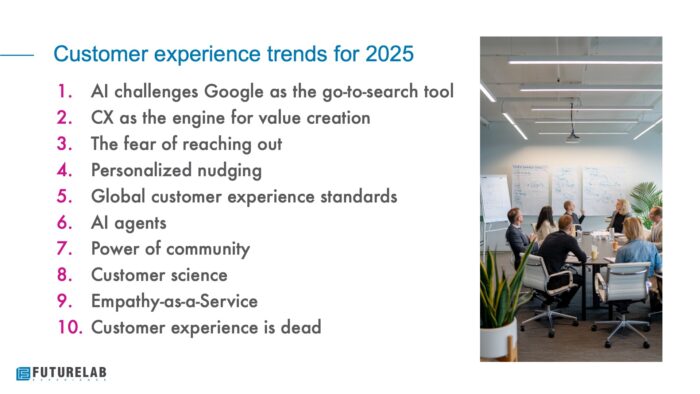
Below is a detailed description of the 10 customer experience trends for 2025:
1. AI challenges Google as the go-to search tool
We have been “Googling” for a long time. Google has dominated information search for two decades. It’s no surprise the term has become embedded in daily language. Occasionally, new search engines appear in the media claiming to challenge Google, but they quietly fade. I even wrote a couple of years ago that TikTok is becoming a search engine of choice for younger audiences.
But now something truly new might be emerging. According to research and daily observations, AI services are taking on a new role. In my own circle, family member no longer Google specs for monitors compatible with a PlayStation 5; he asks ChatGPT whether a certain monitor is suitable, and ChatGPT provides a detailed analysis.
Research backs this up. Prophet surveyed 2,500 people about their use of generative AI. 45% had used AI in the last six months, and over 90% of them used it for personal purposes. The role of search is also industry-specific. Now is a good time to ensure your digital content is structured in a way that AI services can easily find and understand it. Even Google is evolving with its own AI tool, ready to cannibalize its traditional search model.
2. Customer experience as the engine for value creation
One recurring theme I’ve followed is the rising idea of the “transformation economy.” Related literature has introduced fresh perspectives for me.
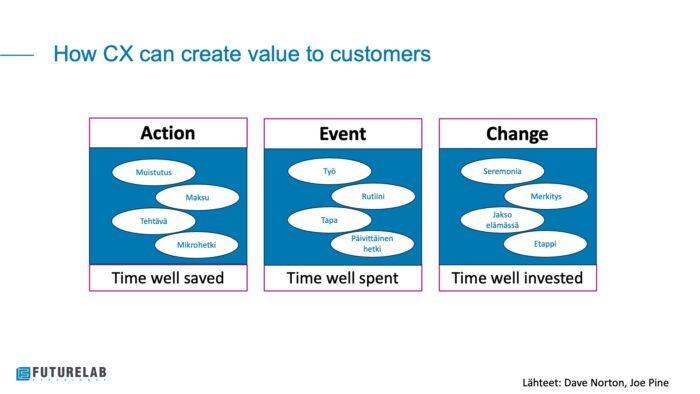 Customer experience as a value creator isn’t new, but it’s worth revisiting because value can be created at different levels:
Customer experience as a value creator isn’t new, but it’s worth revisiting because value can be created at different levels:
- Time well saved: improving the experience by eliminating time-consuming steps (e.g., auto-filling contact info, streamlining grocery shopping).
- Time well spent: creating enjoyable or meaningful moments (e.g., routines that bring value or pleasure).
- Time well invested: driving transformation by encouraging customers to invest time (e.g., travel, fitness, skill development).
This last layer is especially promising in B2B: what does a company offer to its customers’ employees that makes them invest their time, money, or skills beyond the product or service?
3. The fear of reaching out
Forecasts suggest purchasing power is recovering, leading to potential new customers or additional purchases. However, customers often hesitate to reach out. According to Shep Hyken, 43% of people would rather clean a toilet than contact customer service.
Customers prefer self-service. Forrester found that 70% favor self-service for simple issues. But when problems become complex or self-service fails—these are key loyalty moments. In 2025, we must ensure customers no longer hesitate to reach out.
4. Personalized nudging
I’m honestly tired of the overhyped promise of “AI-powered hyper-personalization.” Customer experience should always be personal. Self-service has removed the human dimension. Real personalization can happen in conversation where the customer co-shapes the process. Or it can of course created by AI assisted solutions, which give customers the “feeling” that interaction is personal.
This is where behavioral science concepts like “nudging” come in — gently guiding customers toward favorable actions without coercion. Examples include:
- Reminders to save money just before payday
- Suggestions on loan repayments
- Alerts to optimize electricity use
- Grocery reorder nudges
These are not new, but AI enables smarter timing and more context-aware nudges. Nudging is not pushing; it’s a way to create ease, emotion, and long-term customer value.
5. Global customer experience standards
Standards often scare people—seen as the enemy of creativity. But global CX standards are not top-down rules but born from companies seen as industry leaders.
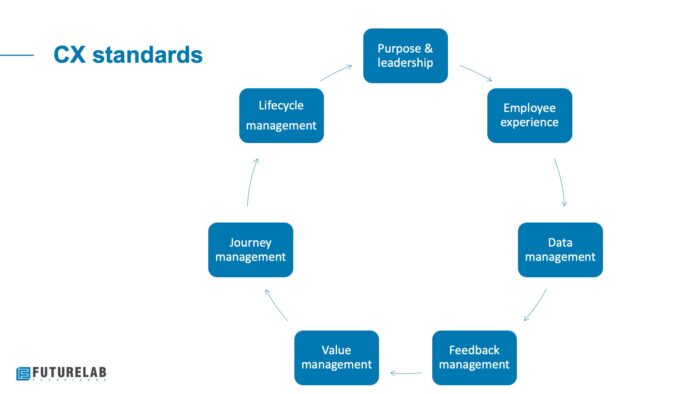 These standards provide a helpful framework for focusing on strategy rather than just processes. The goals include:
These standards provide a helpful framework for focusing on strategy rather than just processes. The goals include:
- Building a customer-centric culture
- Developing CX competencies
- Supporting CX improvement plans
Too often, organizations focus on narrow areas like collecting feedback. A standard helps create a shared understanding and solid foundation for CX professionals.
6. AI agents
AI is a dominant trend again for good reason. Even one year in “AI time” feels like a lot. Some say we’ll hit limits in a few years as training data dries up. But the next step is clear: AI agents.
AI agents are:
- Autonomous apps that perform tasks
- Learning and evolving
- Capable of using other tools (e.g., email)
They serve both companies and consumers. Agents can make purchases, optimize savings, or assist in everyday tasks. From a CX perspective, agents could consider not just price but also NPS scores or employee capabilities. Imagine a buyer’s AI agent negotiating with a seller’s AI agent. Who wins?
7. Power of community
When we asked how customers wanted to attend Futurelab’s CEM DAY 2024, many wanted to be there in person: “I spend enough time in front of a screen already.”
Digital touchpoints are efficient but often forgettable. Easy interactions don’t create lasting impressions. Community offers something more—shared experiences, trust, and belonging.
Whether physical or digital, communities:
- Deepen relationships
- Create emotional value
- Give customers a role in the brand
- Support employees with meaningful work
AI-enhanced self-service may be convenient, but communities build real connection.
8. Customer Science
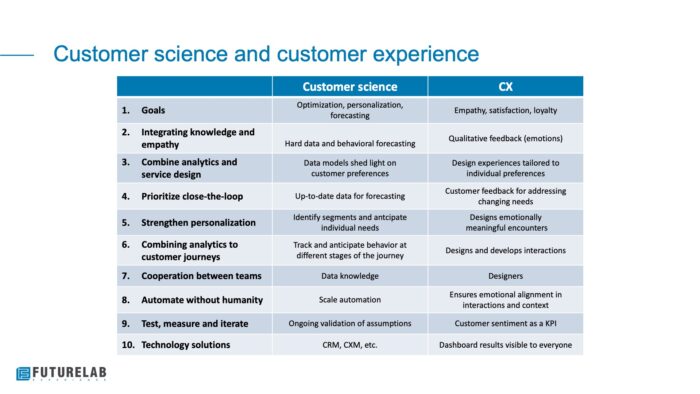 “Customer Science” is a relatively new term gaining attention. Early mentions include a 2017 LinkedIn post by Steven van Belleghem and a 2020 article by Colin Shaw, who defined it as the intersection of AI, behavioral science, and data to better understand customers and drive growth.
“Customer Science” is a relatively new term gaining attention. Early mentions include a 2017 LinkedIn post by Steven van Belleghem and a 2020 article by Colin Shaw, who defined it as the intersection of AI, behavioral science, and data to better understand customers and drive growth.
I’ve tried to popularize the term in Finnish: “Asiakastiede.” It’s not an entirely new idea but a broader way to lead customer relationships by combining knowledge and emotion.
9. Empathy-as-a-Service
If more interactions are digital, does that mean we lose the human emotional touch? Or is the opposite true—humans are unreliable because their moods vary?
“Empathy as a Service” means using AI to sense and respond to emotional states (via facial expressions, voice, or device data). AI isn’t truly empathetic but can simulate it.
Instead of using AI only for efficiency, let’s use it to humanize digital interaction. In retail, AI can detect frustration and offer support. In healthcare, it can provide support between appointments. In education, it can nudge students to stay engaged.
Let’s shift the thinking: AI isn’t a threat to empathy—it can become its translator.
10. Customer experience is dead
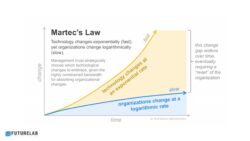
I got excited about CX 15 years ago and have focused on strategic consulting since 2010. Back then, CX was niche. Today, it’s in the boardroom—but often still more of a buzzword than a reality.
Is CX dead or dying? Maybe it’s time to re-evaluate. As Scott Brinker’s “Martec’s Law” reminds us, tech changes exponentially, but organizations evolve slowly. Customers adopt new behaviors fast, but companies lag. Linear improvements aren’t enough. We need bold strategic shifts. CX isn’t dead—but unless we find a new perspective and renewed energy, it risks becoming irrelevant.
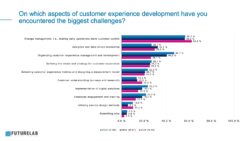 Many organizations are working to become more customer-centric. But why isn’t that reflected in feedback and improved experience? Now is the time to aim higher—not just tinker, but transform.
Many organizations are working to become more customer-centric. But why isn’t that reflected in feedback and improved experience? Now is the time to aim higher—not just tinker, but transform.
Finding and writing the 2025 trends turned out to be easier than expected. The process gave me new ideas and energy. I hope these trends will help you in your work this year. Feedback and comments are always welcome!




Comments are closed here.